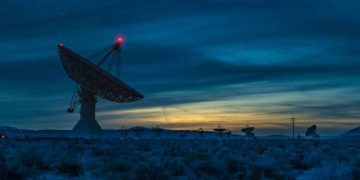A conference scheduled in the UK this week will highlight recent developments in the pursuit of ‘technosignatures’ from advanced extraterrestrial civilizations. This field has historically yielded limited conclusive findings over the past six decades, despite sustained efforts by researchers seeking evidence of intelligent life beyond Earth.
Breakthrough Listen, renowned as the largest global initiative dedicated to this quest, anticipates significant breakthroughs due to upcoming technological innovations. These advancements will be showcased at their annual conference in Oxford, marking the first UK-hosted event of its kind and attracting hundreds of scientists from diverse fields.
Steve Croft, an astronomer affiliated with Breakthrough Listen, underscored the transformative impact of forthcoming technologies. “Exciting advancements include the deployment of expansive new telescopes in Chile, Africa, and Australia, alongside developments in AI,” he stated. These innovations are poised to revolutionize the methodology of detecting extraterrestrial civilizations.
Key among these advancements are the Square Kilometre Array, a network of radio telescopes under construction in South Africa and Australia, and the Vera Rubin Observatory in Chile, set to house the world’s largest camera. These facilities promise unparalleled capabilities, with the former becoming the preeminent radio astronomy hub worldwide and the latter enabling comprehensive sky imaging every few nights, potentially revealing millions of new celestial objects.
Croft emphasized the role of AI in enhancing data analysis, crucial for discerning subtle patterns indicative of intelligent life. “Previously limited to detecting deliberate signals broadcasted by alien societies, these new techniques will allow us to identify unintentional transmissions, such as airport radar or powerful TV signals,” he explained.
Astrophysicist Prof Adam Frank of the University of Rochester supports this approach, emphasizing the significance of identifying ‘technosignatures’—traces of routine activities that could indicate the presence of advanced civilizations. These signatures range from artificial lighting to atmospheric changes and even speculative indicators like extensive solar panel arrays, which might reflect distinct ultraviolet and infrared emissions detectable by advanced telescopes.
Astrobiologist Lewis Dartnell further elaborated on the challenges involved in such searches, noting the substantial observational efforts required to identify potential alien artifacts on distant planets.
The upcoming conference aims to galvanize international efforts in the search for extraterrestrial intelligence, marking a pivotal moment in humanity’s quest to understand its place in the cosmos.
Stay informed on supply chain news at The Supply Chain Report. Free international trade tools are at ADAMftd.com.
#AlienLifeSearch#Technosignatures#SpaceTechAdvancements#BreakthroughListen#SupplyChainNews

















